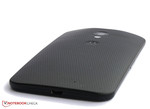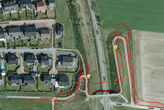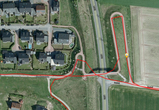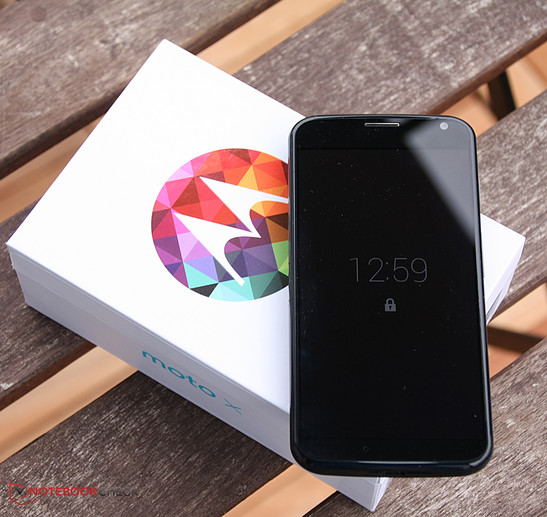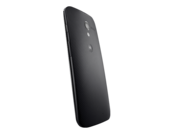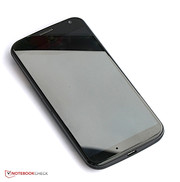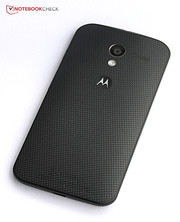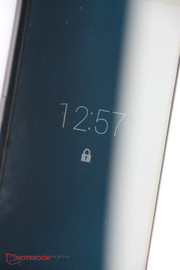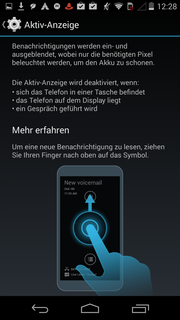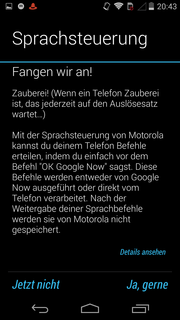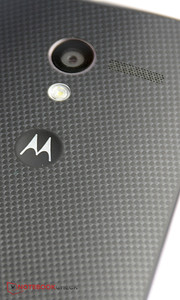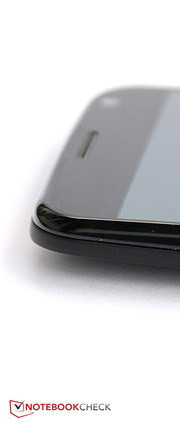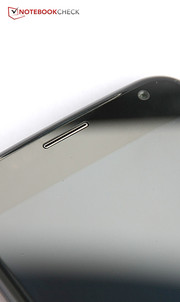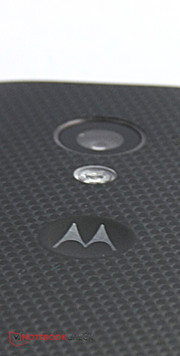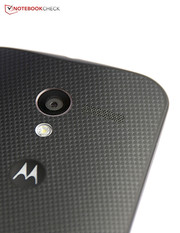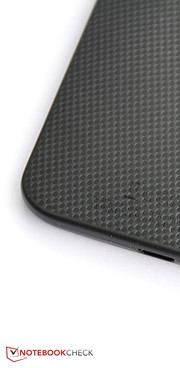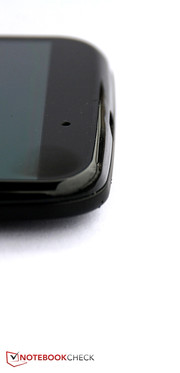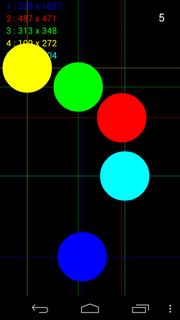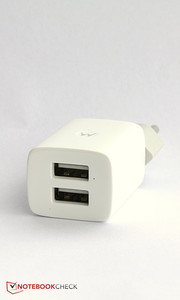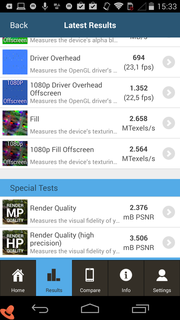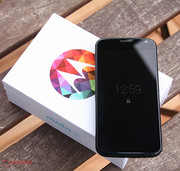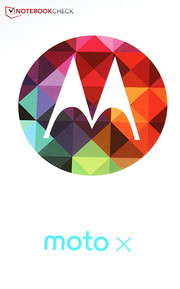Review Motorola Moto X Smartphone

For the original German review, see here.
Google's partnership with Motorola did not last for even two years. The traditional cellphone builder has been sold to Lenovo. The new Moto X will thus likely be the last smartphone that Motorola creates under Google's leadership. Motorola was never one of the big names on the cellphone market, but it repeatedly attracted attention with unusual products that advanced the market. For example, the ultra-thin Razr flip phone or the Razr i smartphone with an Intel Atom processor.
This tradition is naturally to be preserved in the new Moto X, and the tight relationship with the soon to be ex-parent company Google is, of course, to bring along advantages for the user, and also fuel sales - all at the same time. Therefore, Motorola installs two very economic processing cores that are activated in standby instead of the main processor. This is to save energy while allowing special features, e.g. Active Display with the most important information in standby, and the fully integrated speech control Google Now.
Interesting features, but the Motorola Moto X's doom could be that many exciting contenders are found in the 350 Euro (~$483) price range. For example, Google's Nexus 5 that convinces many users with its extreme performance, and the proprietary as well as easy-to-upgrade Android. LG's Optimus L9 II fuses high-performance with a low price. Alcatel's One Touch Idol X is very thin and colorful, and likely wins over many hearts just for its looks. Even Acer has a mid-range smartphone dubbed Liquid S1 on the market, and Huawei's Ascend G700 also offers a very good price-performance ratio. Users who do not insist on Android will find an interesting alternative in Nokia's Lumia 625 Windows Phone.
Case
Black and white are the only colors? In a time where even Apple breaks with tradition and offers a colorful iPhone 5c? In a conversation at the press event for the launch, Motorola justified the rather classic color palette with the target audience who is more interested in technical innovations, and wants an unobtrusive device
Unobtrusive is a very fitting description for the phone. Our black review sample's back struck us most. Its roughened surface is pleasing, and the slightly submerged Motorola logo offers the index finger grip right away. However, the screen's bezel on the front is glossy, and thus inconsistent with the design. It almost seems as if the Moto X were assembled using two halves of different devices.
The touch buttons are integrated into the screen. This allows a low height. The casing's thickness is not as compelling. The smartphone's thickest spot is 10.4 millimeters, which is also due to the curved back that lies nicely in the hand. Alcatel's One Touch Idol X has a far lead with just 6.9 millimeters.
The casing's build and rigidness are absolutely satisfactory. Even strong pressure on the smartphone does not affect the screen, and the device cannot be warped either.
Connectivity
The connectivity of Motorola's Moto X is throughout standard for a mid-range smartphone, and lacks real highlights: a 1.5 GHz dual-core processor alongside the mentioned additional cores that are only activated when the phone is in standby. 16 GB of storage that cannot be expanded, and of which only roughly 12 GB is available in state of delivery. A micro-SD card cannot be inserted, and the battery cannot be removed. The physical interfaces, in the forms of a micro-USB port and 3.5 mm headset jack, are also standard.
Software
The user benefits from Motorola's still existing relationship to Google. The latest Android 4.4.2 version is installed in its original state. This has the advantage that software updates from Google do not have to be first modified, but can be installed directly.
As frequently said, the standby mode features a different design than that of standard Android smartphones. A very fundamental desktop appears when the phone is picked up, and displays the time, notifications about messages and calls. It is also possible to let the time and displayed information blink in regular intervals. According to Motorola, many users only look at their smartphone to see what time it is, and whether there are any new messages. However, this uses too much power because the processor has to load, the screen fully lights up, etc.
Motorola promises longer battery runtimes with its Active Screen since an especially economic, dedicated processing core is assigned to this desktop. Further details, such as the first words of the message or the caller's name, can also be displayed on the standby interface without booting the operating system. The entire bundle resembles basic secondary operating systems that are sometimes found in multimedia laptops, or even the second screen in flip phones. Basically a good idea that works smoothly and instinctively.
Motorola Assist is integrated as special software. It detects Bluetooth connections and Wi-Fi networks in the phone's vicinity. The phone does not ring when driving, and thus the driver is not distracted. Messages and calls can also be disabled in the night, but exceptions can always be selected.
Motorola Connect is an extension for Google's Chrome browser. It displays incoming messages directly in the browser, and can also be answered from there. The Moto X has to be connected with the computer via Bluetooth for this.
As a special bonus, the user receives 50 GB of storage on Google Drive for two years without charge when buying the Moto X.
Communication & GPS
The variety of wireless communication options is agreeable: Motorola's Moto X enables quad-band GSM, hexa-band UMTS, and even tri-band LTE with up to 42 Mbit. Besides the latest Bluetooth 4.0 version, Wi-Fi is, of course, also installed. Wireless networks can even be used in the newest 802.11 ac standard.
The Wi-Fi module's transmission quality is satisfactory. Three-quarters of the signal strength was still displayed at a distance of 10 meters, and through three walls. The signal's quality fluctuated between one-half and one-quarter when another wall and two meters were placed between the phone and the router. Nevertheless, websites still loaded quite fast.
We tested the GPS module on a bicycle trip, and compared its accuracy with a Garmin Edge 500 navigation system. Overall, the GPS module in the Moto X proved to be quite accurate, although the measured rates were not always precisely on route. However, the pro navigation device also deviated occasionally. The GPS module also scored well in the test with the GPS Test app. Although it needs a moment until enough satellites were found for localization, the location was determined accurately up to a few meters. Localization was also possible indoors though not as precise as when outdoors.
Telephony and Speech Quality
The speech quality is really good. Both the caller and the called party sound loud and clear. The volume is even sufficient for louder, public places. Users who use the hands-free feature will also be pleased about the very good speech quality, and the called party can even be heard across the entire room at maximum volume.
Cameras and Multimedia
The rear-facing camera of the Moto X offers 10 megapixels, which corresponds to a resolution of 4320x2432 pixels. In addition to the RGB colors, i.e. red, green and blue, the camera should also be able to process white pixels, which allegedly leads to brightening dark corners without noise. In fact, the camera manages to clearly enhance pictures shot in poor light conditions. Nevertheless, a distinct image noise is still visible, and the picture quality is rather weak. The additional contrasting color has quite a positive effect on the picture quality in normal light conditions though, as can be seen in the comparison screenshots. The pictures look brilliant and colorful even in dim winter light, but they also make a slightly unnatural impression. Generally, the picture focus is good, but sometimes varies with the automatic.
The front-facing 2 megapixel camera is intended for video calls, and an occasional self-portrait. Its Full HD resolution of 1920x1080 pixels is enough for that, but the pictures are often overall a bit unfocused, and the colors are too intense.
Accessories
The user will have to buy a headset because Motorola does not include one. However, there is an unusual charger with two USB ports - thus, two devices can be recharged simultaneously. No optional accessories are offered for the Moto X on the website.
Warranty
Motorola includes a 24-month warranty on the Moto X. The warranty is only applicable in the country where the phone was purchased. Fair: The warranty is valid for at least 90 days after a repair, even if this period goes beyond the actual warranty period.
Input Devices and Controls
The Moto X features Android in its original state, which also applies to the on-screen keyboard. Users who have owned an Android smartphone will get along right away. Everyone else will also adapt quickly owing to the keys' intuitive layout. The keys are relatively big and easy to hit in portrait mode due to the 4.7-inch screen. Using both hands is logical in landscape mode. The capacitive touchscreen also contributes to the pleasant handling: It is easy to use, responds to inputs reliably up into the edges, and is sleek.
As a highlight, Motorola fully integrates the voice control Google Now in the usage. The Moto X even monitors the microphone in standby using one processor core, and responds to the phrase "OK, Google Now." Pursuing that, a search request can be made, an appointment can be dictated, or a message can be sent - all via voice input. The phone answers directly to a few simple questions, such as, "how high is the Eiffel Tower?" The question is passed on to Google Search otherwise. Voice control works quite reliably overall, and it responds quickly to speech in standby.
The camera can be enabled by twisting the wrist with the smartphone twice, which is a slightly unusual gesture but which works reliably.
Display
An increasing number of smartphones with Full HD resolution are now also accumulating in the mid-range category. The Moto X is still a bit restrained, and only offers a resolution of 1280x720 pixels on its 4.7-inch screen. This is still ahead of Nokia's Lumia 625 that has a resolution of just 480x800 pixels.
The average brightness of only 314.1 cd/m² clearly places Motorola's Moto X at the end of the comparison field. Huawei's Ascend G700, for example, provides 542.6 cd/m². However, the illumination of the Moto X is distributed very evenly over the screen.
| |||||||||||||||||||||||||
Brightness Distribution: 97 %
Center on Battery: 309 cd/m²
Contrast: ∞:1 (Black: 0 cd/m²)
ΔE ColorChecker Calman: 5.06 | ∀{0.5-29.43 Ø4.77}
ΔE Greyscale Calman: 1.14 | ∀{0.09-98 Ø5}
Gamma: 2.46
CCT: 6495 K
The contrast is very, very high because the AMOLED screen is not illuminated from the back, and thus enables absolutely black pixels. The colors also look rich, and black makes a very dark subjective impression.
Consequently, the shifts for all grayscales are very low in the grayscale tests using CalMAN software and colorimeter. The color accuracy and saturation of most color levels also only deviate moderately. This is likely due to the extremely reduced blue part. The colors generally look richer than they should according to the reference color space, resulting in a very bright, but also a slightly unnatural color impression.
The screen's only middling brightness is noticed unfavorably outdoors. The reflective screen also barely lets anything be recognized on bright days. However, the brightness is sufficient for indoor use and shadowy places.
Performance
Motorola's Moto X sports a Qualcomm Snapdragon S4 MSM8960DT. The SoC features two processing cores that clock with up to 1.73 GHz. "DT" behind the model name indicates that two processor cores are installed, which only ensure that Active Display and Google Now voice control are active in standby. They have a low clock rate, and thus consume very little energy.
The synthetic benchmarks show that the system can even compete with Google's Nexus 5 on the whole. However, the pure CPU power of the Moto X is approximately 30% lower. All inputs we made in routine use were implemented quickly; working with the smartphone was agreeably smooth and pleasant.
| Smartbench 2012 - Productivity Index (sort by value) | |
| Motorola Moto X 1. Gen 2013 | |
| Alcatel One Touch Idol X | |
| LG D605 Optimus L9 II | |
| Google Nexus 5 | |
| Acer Liquid S1 | |
| Huawei Ascend G700 | |
As to graphics performance, Motorola's Moto X is at the very front with its Adreno 320 graphics solution. The synthetic benchmarks show that the phone is almost always at the top of the comparison field. The significance for (gaming) routine can be seen in the comparison chart below Gaming Performance.
| 3DMark | |
| 1920x1080 Ice Storm Extreme Score (sort by value) | |
| Motorola Moto X 1. Gen 2013 | |
| Alcatel One Touch Idol X | |
| Acer Liquid S1 | |
| Huawei Ascend G700 | |
| 1920x1080 Ice Storm Extreme Graphics (sort by value) | |
| Motorola Moto X 1. Gen 2013 | |
| Alcatel One Touch Idol X | |
| Acer Liquid S1 | |
| Huawei Ascend G700 | |
| 1920x1080 Ice Storm Extreme Physics (sort by value) | |
| Motorola Moto X 1. Gen 2013 | |
| Alcatel One Touch Idol X | |
| Acer Liquid S1 | |
| Huawei Ascend G700 | |
| Basemark ES 2.0 - Taiji Free (sort by value) | |
| Motorola Moto X 1. Gen 2013 | |
| Alcatel One Touch Idol X | |
| LG D605 Optimus L9 II | |
| Google Nexus 5 | |
| Acer Liquid S1 | |
| Huawei Ascend G700 | |
| NenaMark2 - --- (sort by value) | |
| Motorola Moto X 1. Gen 2013 | |
| Alcatel One Touch Idol X | |
| LG D605 Optimus L9 II | |
| Google Nexus 5 | |
| Acer Liquid S1 | |
| Acer Liquid S1 | |
| Huawei Ascend G700 | |
Google's Nexus 5 and Alcatel's One Touch Idol X are the hottest contenders in the battle for the performance crown in terms of Internet usage. Both recurrently surpass Motorola's Moto X, but they are also sometimes clearly defeated. This proves that the Moto X plays at the top of the mid-range category in speedy browsing. In fact, quick website loading and smooth scrolling were noticed very positively in routine use.
| Peacekeeper - --- (sort by value) | |
| Motorola Moto X 1. Gen 2013 | |
| Alcatel One Touch Idol X | |
| LG D605 Optimus L9 II | |
| Google Nexus 5 | |
| Acer Liquid S1 | |
| Huawei Ascend G700 | |
| Nokia Lumia 625 | |
| Sunspider - 1.0 Total Score (sort by value) | |
| Motorola Moto X 1. Gen 2013 | |
| Alcatel One Touch Idol X | |
| LG D605 Optimus L9 II | |
| Google Nexus 5 | |
| Google Nexus 5 | |
| Acer Liquid S1 | |
| Huawei Ascend G700 | |
| Nokia Lumia 625 | |
| Mozilla Kraken 1.1 - Total (sort by value) | |
| Motorola Moto X 1. Gen 2013 | |
| Alcatel One Touch Idol X | |
| LG D605 Optimus L9 II | |
| Google Nexus 5 | |
| Acer Liquid S1 | |
| Huawei Ascend G700 | |
* ... smaller is better
Even if Alcatel's One Touch Idol X or Google's Nexus 5 are sometimes faster in write and read - the storage in Motorola's Moto X operates very fast, and clearly places itself at the top in random write. The time needed for apps to open was short, and data transfer to a PC was very swift.
Gaming Performance
The Adreno 320 graphics chip in Motorola's Moto X clocks with 400 MHz. It was launched in 2012, but powers graphics in premium devices like Sony's Xperia Z or LG's Optimus G Pro. Now it has arrived in the mid-range, but is still strong enough for games from the Play Store. Undemanding casual games, such as Angry Birds: Star Wars 2, run just as smoothly as 3D games like Iron Man 3.
Emissions
Temperature
We did not ascertain any big differences in the casing temperatures of the Moto X and the comparison devices. Like its contenders, the Moto X remains quite cool. The absolute maximum temperature that we achieved in our test was 38.1 °C on the back. That is still lukewarm. Of course, some devices, such as Huawei's Ascend G700, undercut this temperature with 34.5 °C, but holding the Moto X is agreeable in every state, like all comparison devices.
(+) The maximum temperature on the upper side is 37.1 °C / 99 F, compared to the average of 35.2 °C / 95 F, ranging from 21.9 to 247 °C for the class Smartphone.
(+) The bottom heats up to a maximum of 38.1 °C / 101 F, compared to the average of 34 °C / 93 F
(+) In idle usage, the average temperature for the upper side is 25.6 °C / 78 F, compared to the device average of 32.9 °C / 91 F.
Speakers
The speaker is located on the back beside the camera. This is a good place because the hand does not cover the speaker there. The speaker emits music, speech, and noise with pressure. A big room can be easily filled with sound. The sound remains clear and differentiated even in very high volumes, but it unfortunately lacks bass. Nevertheless, the sound is more than sufficient for occasional YouTube videos and music. The headset port on the upper edge produces a decent sound, and the only thing needed is good headphones.
Energy Management
Power Consumption
The power consumption of Motorola's Moto X is roughly on par with the comparison devices. The smartphone consumes an average of 1 watt when idling, and is thus in the lower midfield, and in front of, for example, Alcatel's One Touch Idol X and Acer's Liquid S1. The maximum consumption of 3.9 watts is also on the level of the other dual-core smartphones in the comparison.
The Active Display's positive impact on the power consumption is difficult to ascertain. Motorola promises much lower power consumption because the main processor does not have to load when the user only wants to read the time and check new messages. Since the standby consumption of 0.3 watts is on par if not lower than that of the comparison devices, Motorola seems to keep its promise. The lower clocked, dedicated processor core that is responsible for Active Display only consumes about half the power that the main processor needs in minimum (lowest idle consumption: 0.6 watts).
| Off / Standby | |
| Idle | |
| Load |
|
Key:
min: | |
Energy Management
The lithium-ion battery in Motorola's Moto X can supply 9 watt hours. It is considerably stronger than in most of the compared smartphones. Only Acer's Liquid S1 has a slight advantage with 9.12 watt hours. Considering this fact, the battery runtimes are disappointing, in particular in the real-life Wi-Fi test. Our review sample lasted for just under six hours. Google's Nexus 5 and Huawei's Ascend G700 clearly last longer. The Moto X is again on par with its contenders in idle and load.
Verdict
We are happy to see that Motorola has not lost its spirit for innovation, and again proves that one can show even smartphone moguls that there is still some room for improvement with clever ideas. Active Display is a very useful feature and can increase the only middling runtimes considerably in routine use.
Motorola has also done a good job with the screen. Relatively minor color shifts, a very good contrast, and a deep black result in a great picture. It only could be brighter, and the colors might shine a bit too intensely for some tastes.
The software bundle, featuring the original Android, the interesting software offerings, and Motorola Connect that allows answering text messages even over the PC, is very well designed. We are just as pleased about the good touchscreen and decent camera. The fully integrated Google Now is also a nice gimmick. Extensive wireless communication equipment, including LTE and high-speed Wi-Fi, are also in the bundle.
Motorola would have to work on the design. The front and back covers do not really match. There is actually not much more to complain about. The Moto X is more than a solid and very powerful mid-range smartphone that stands out with clever ideas. Users who can live with the design should definitely take a look at the phone.


